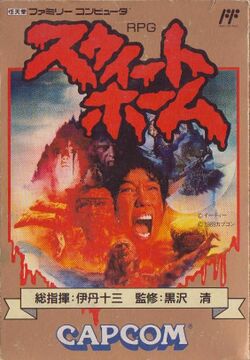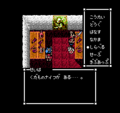
| Sweet Home | |
|---|---|
| Developer(s) | Capcom |
| Publisher(s) | Capcom |
| Year released | 1989 |
| System(s) | Famicom |
| Genre(s) | Survival horror RPG |
|---|---|
| Modes | Single player |
Sweet Home (スウィートホーム?) is an RPG developed and published by Capcom for the Famicom in 1989. It is based on the Japanese horror film of the same name and tells the story of a team of five filmmakers exploring an old mansion in search of precious frescos hidden there. As they explore the mysterious mansion, they encounter hostile ghosts and other supernatural enemies. The player must navigate the intricately laid out mansion, battling with the enemies, and the five main characters with the limited weapons and health restorative items available. The narrative moves forward regardless of whether the characters stay alive, and leads to its five different endings.
The game was directed by Tokuro Fujiwara, who previously worked primarily on arcade games such as Ghosts 'n Goblins. Fujiwara toured the film's set to gather inspiration for the game, and the film's director Kiyoshi Kurosawa gave Fujiwara permission to take some liberties with the game's script. Sweet Home was released in December 1989 exclusively in Japan, where it gathered generally favorable reception and was considered better than the film. The game was never localized to western markets, likely because of the game's gruesome imagery and the unpopularity of role-playing games outside Japan.
In retrospect, Sweet Home is considered a landmark game and is often cited for laying the groundwork for the survival horror genre. It served as the main inspiration behind Resident Evil which was a massive critical and commercial success, launching a multimedia franchise. Later games in the future continue to pull inspiration from the game through the use of quick time events, inventory management, and ghost story elements. Sweet Home's Metroidvania-style exploration, storytelling methods, and horror elements have been cited as precursors to key elements found in other successful games decades later.
-
Title screen
-
Game screen
Plot[edit]
The plot of the game focuses on a team of five people that enter Lady Mamiya's mansion in order to photograph her frescoes for a documentary. However, when they step inside, the doors shut behind them and they become trapped in what they soon learn is a haunted house. The team must then work together to escape before they become victims of the angered spirits within.
Gameplay[edit]
Sweet Home is an RPG set within a mansion that has a cohesive, intricate layout. There are five playable characters who can venture solo or explore in teams of two or three. The player can switch between characters and parties at any time. The five characters each have a unique item that is necessary to complete the game: a camera, lighter, medical kit, lockpick, and vacuum cleaner. Along with these items are others that can be picked up and dropped anywhere and retrieved later by other characters.
Sweet Home places an emphasis on puzzle-solving, item inventory management, and survival. The player must backtrack to previous locations in order to solve puzzles using items acquired later in the game. In this sense, the interconnected mansion is gradually explored in the style of Metroidvania games. Enemies are encountered randomly and the player must fight or run away through menu-based combat. The battles are presented in a first-person perspective, and there are a variety of enemies, including zombies, ghosts and dolls.[ The only way to restore health is through tonics scattered across rooms in the mansion.
The story is told through cinematic cutscenes and through optional notes such as secret messages and diary entries of past visitors scattered across the mansion, which also provide clues for solving puzzles. The game also features quick time events when the player comes across a trap that requires a quick decision to be made, or else be killed. When a character dies, they remain dead permanently for the remainder of the game. Items that serve the same purpose as the dead character can be found near their corpse. For example, should the team nurse Akiko die, the team may find pill bottles which can be used to heal ailments. Depending on how many characters remain alive after the defeat of the final boss, there are a total of five different endings the player may receive.



